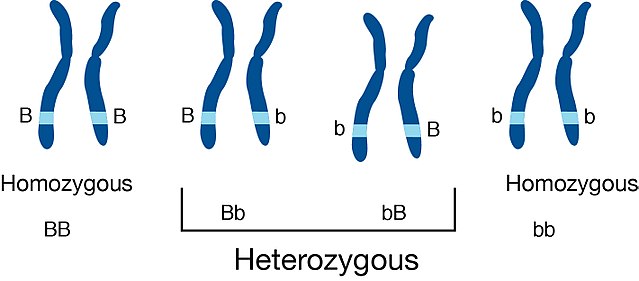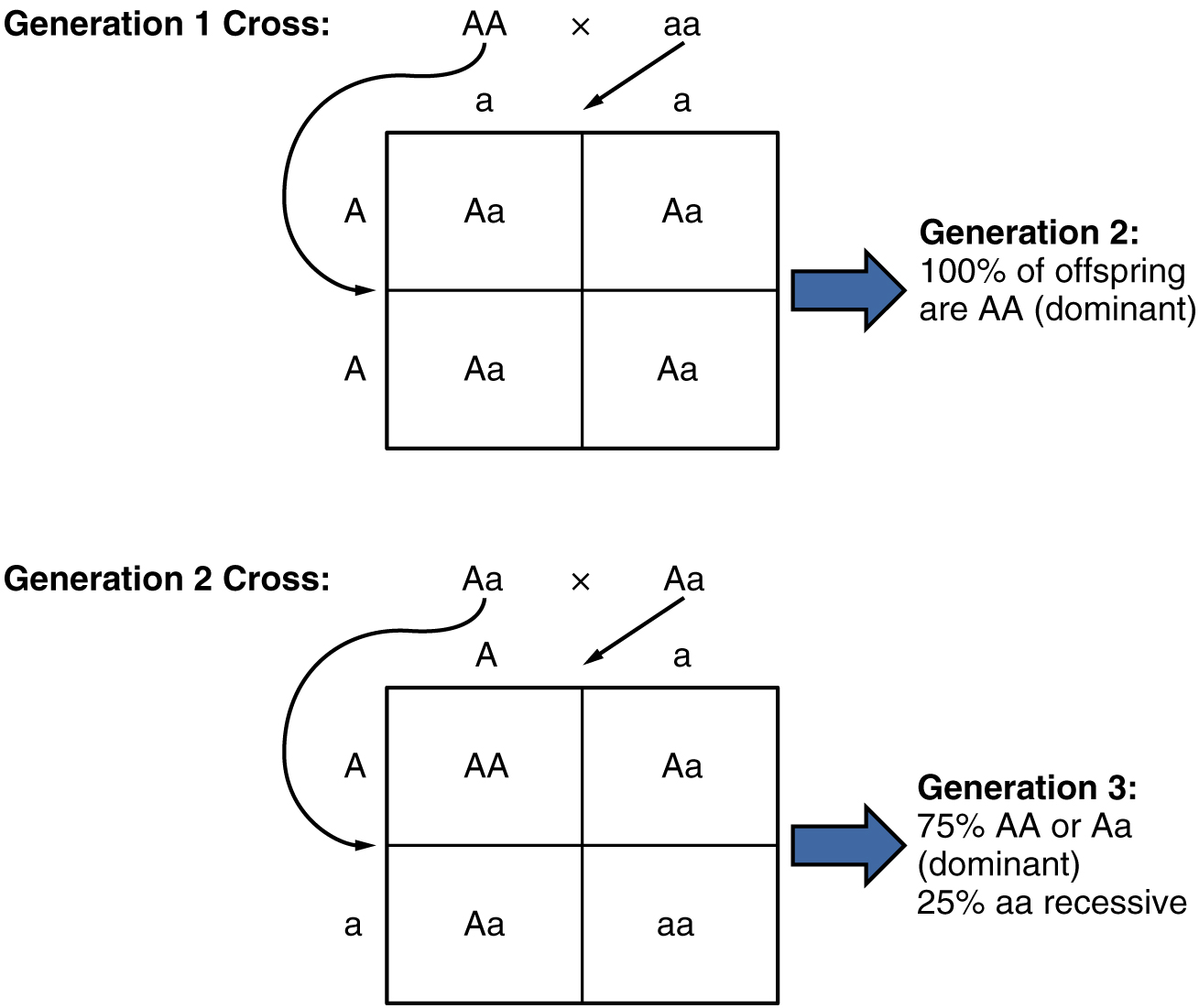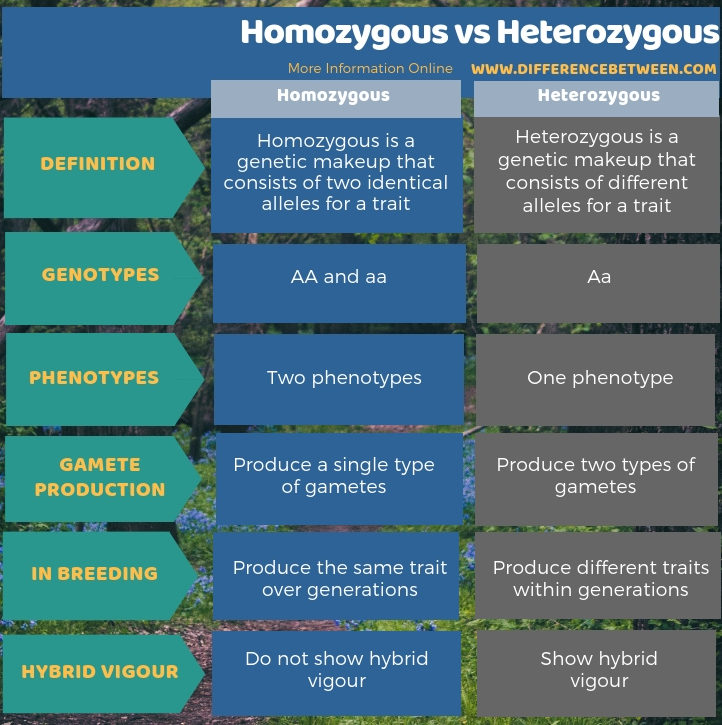Difference Between Homozygous and Heterozygous
Table of Contents
The key difference between homozygous and heterozygous is that homozygous means both alleles are similar for a trait while heterozygous means the two alleles are different for a trait.
The genes inherited from the parental chromosomes control all the characters or traits of animals, plants, and all other living beings. It is the core reason for showing parental characteristics in the progeny. Most eukaryotic organisms have two sets of genes known as maternal genes and paternal genes. Therefore, the genetic situation is known as diploid (two sets of chromosomes). That means; all the traits have genetic components from both mother and father. However, these genes could be either dominant or recessive over each other and that is where homozygous and heterozygous characteristics become important. Homozygous is a state of having two dominant alleles (AA) or two recessive alleles (aa) while heterozygous is a state of having one dominant allele and one recessive allele (Aa).
CONTENTS
1. Overview and Key Difference
2. What is Homozygous
3. What is Heterozygous
4. Similarities Between Homozygous and Heterozygous
5. Side by Side Comparison – Homozygous vs Heterozygous in Tabular Form
6. Summary
What is Homozygous?
Homozygous genes consist of two similar types of paternal and maternal genes. However, dominant and recessive characters are important to consider. For example, when a child receives one dominant allele (S) from mother and the same type of dominant allele (S) from father, the child is homozygous dominant (SS) for that particular trait. Similarly, if the alleles inherited from mother and father are both recessive, indicated by the lower case ‘s’, then the child is homozygous recessive (ss) for that particular trait. Therefore, homozygous genotypes can have either two dominant or two recessive traits.

Figure 01: Homozygous
The ‘SS’ situation is known as the dominant homozygous genotype while the ‘ss’ situation is the recessive homozygous genotype. The dominant homozygous genotype expresses dominant phenotypes while recessive homozygous genotype expresses recessive phenotype.
What is Heterozygous?
Heterozygous genes have different types of genes for a particular phenotype. That means; the genetic makeup of a particular character or phenotype does not contain similar types of genes. There are two basic types of genes as dominant and recessive. Therefore, heterozygous genotypes or alleles have one dominant gene with one recessive gene responsible for a particular character. However, in the case of a heterozygous genotype, only the dominant gene is expressed as the phenotype; the externally visible or functional character.

Figure 02: Heterozygous
There is no rule that the dominant gene should come from the maternal or paternal genes; thus, any type of expressivity (either dominant or recessive gene) could be inherited from any parent. If the dominant gene ‘S’ from one parent couples with the recessive gene ‘s’, then the progeny will be heterozygous (indicated as ‘Ss’). Thereafter, only the dominant gene ‘S’ will be expressed, dominating over the recessive gene ‘s’.
What are the Similarities Between Homozygous and Heterozygous?
- Homozygous and heterozygous are two states of genotypes.
- Both states consist of two alleles.
- Also, they are present at the same locus of homologous chromosomes.
What is the Difference Between Homozygous and Heterozygous?
Homozygous genotype contains the same type of genes responsible for a particular phenotype whereas heterozygous genotype contains one dominant gene with one recessive gene in the diploid genetic setup. So, this is the key difference between homozygous and heterozygous. Furthermore, there are two types of homozygous genotypes as dominant homozygous and recessive homozygous. On the other hand, heterozygous genotype has only one type. Hence, this is also a difference between homozygous and heterozygous. In homozygous genotypes, there are two types of phenotypes expressed while only one type is expressed in heterozygous genotypes.
The following infographic presents more information on the difference between homozygous and heterozygous.

Summary – Homozygous vs Heterozygous
Diploid organisms possess two sets of chromosomes; one copy comes from the egg and the other copy comes from the sperm. Similarly, each gene has two alternate forms or alleles. If the two alleles match with each other, we call it homozygous for a trait. Furthermore, there are two types of homozygous state: two dominant alleles or two recessive alleles. In contrast, if the two alleles do not match, we call it heterozygous for a trait. It is the state of having one dominant allele and one recessive allele. Thus, this is the summary of the difference between homozygous and heterozygous.
Reference:
1. “Genotypes and phenotypes” Department of Statistics, University of Washington, Available here.
2. “Genotype” Nature News, Nature Publishing Group, Available here.
Image Courtesy:
1. “Heterozygous” By Darryl Leja, National Human Genome Research Institute – (Public Domain) via Commons Wikimedia
2. “2924 Mendelian Pea Plant Cross” By OpenStax College – Anatomy & Physiology, Connexions Web site, Jun 19, 2013 (CC BY 3.0) via Commons Wikimedia
ncG1vNJzZmivp6x7pbXFn5yrnZ6YsqOx07CcnqZemLyue8OinZ%2Bdopq7pLGMm5ytr5Wau260zqams7GXpMK0ecCnm2auo2K1psDEq6azsZekwrR7